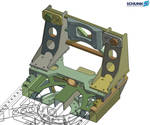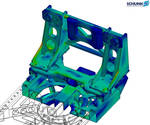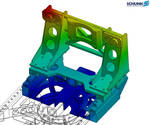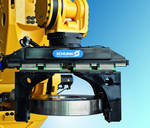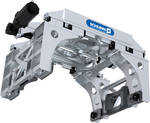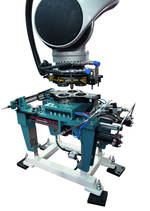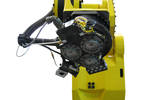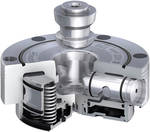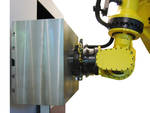| With "M-2000iA" and "Titan" industrial robots have opened up a new performance class. The powerhouses easily cope weights of one ton and more. For being able to handle heavy components safely and efficiently, the brawn of the robots themselves is not enough. Gripping systems and accessories have to be adjusted to the high payloads, too. They should be powerful, flexible and reliable, but also light-weight. SCHUNK, the competence leader for clamping technology and gripping systems, shows how sophisticated components and solutions for the heavyweight league can look like. Standardized heavy-load robots with six axes already achieve payloads of more than 1,300 kg. The giants are particularly suitable for applications in the building materials, the automotive industry or the foundries. For building up wind power stations, they can handle ring gears, bearings and hubs. They palletize granite plates, lift complete car bodies in the automotive industry, or handle finished parts made of concrete. Experts assume that in the future, heavy-load robots will replace indoor cranes. They can work more flexibly, precisely, and on demand, even run completely automatically and unmanned around the clock. Precise and with high cycle times, they locate heavy components to a defined place without risky pendulum motions, and without endangering workers during transportation. According to Matthias Poguntke, Head of Project Management, Industry- and Product Management Automation at SCHUNK, they will play an increasing role in future, even in intralogistics, where the cost pressure in the global competition is increasing. "In the production line the heavy-load robots can partly replace lifting equipment or shuttles, and ensure at the same time that the plant is used effectively, and that stocks are minimized" says Poguntke. Heavy-load robots offer many advantagesCompared with conventional solutions, heavy-load robots offer a higher level of process reliability, flexibility and efficiency to the users. In order that the powerhouses can fulfill these expectations, they need accordingly designed accessories, which absorb the enormous power and moments, and allow for the most efficient work. XXXL- Gripper: Powerful but lightweightFor the Fanuc M-2000iA/1200 SCHUNK has developed a servo-driven heavy-load gripper with a stroke of 100 millimeters per finger at a gripping force of 23,000 Newtons. It handles components of up to 700 kg. The gripper's and jaws' rigidity were optimized with the finite element method (FEM), and ensures that despite the high dynamic payloads no inadmissible forces will occur. At the same time, surplus material is consequently removed. At a weight of just 350 kg, the gripper stands up to all possible obstacles. The gripper provides for maximum safety, and due to the consequent leight-weight design, has the highest possible load capacity. The state-of-the-art gripping system can be driven with various electric motors. The drive is effected via a centrally arranged trapezoidal thread, which evenly and precisely distributes the force onto the roller-guided base jaws. For operation, the gripper is integrated as the seventh axis into the robot's control unit. No additional hardware is necessary, and compatability and integration problems are avoided. Via special adhesive pads at the gripper fingers, the heavy-load gripper adapts to the different workpiece geometries, and even components with large tolerances can be safely handled. In order to avoid the unwanted loss of handling goods, a unique mechanic gripping force maintenance device is integrated in the gripper. Meanwhile SCHUNK offers the SLG heavy-load gripper as a standard module. For special applications SCHUNK is also offering custom-tailored heavy-load grippers. SCHUNK, the innovative family-owened company already designed a hydraulically actuated special gripper for a steel work. The gripper is used at the cleaning places for steel girders. Two grippers per each cleaning place hold the up to ten meters long and about 2,8 t heavy slaps at the end faces. A special spring package for clamping the gripper position was integrated and ensures absolutely reliable gripping of the massive workpieces. This gripping force maintenance is not loosened, before the additional hydraulic line is actuated with a pressure of 100 bar. In case of a failure of the hydraulic system, the slap is reliably held in the gripper. This is the best precondition for maximum process reliability. | 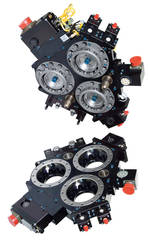 SWS-1210 Equipped with three locking systems, the SWS-1210 can load up to 1,200 kilograms. The attachment surfaces are compatible to the other heavy-load changers from SCHUNK.
|
The Quick-Change Pallet System fixes the components
SCHUNK also continually uses the VERO-S Quick-Change Pallet System for heavy-laod gripping systems. Normally this system is used for high-precision workpiece change in machine tools. The basis of the clamping system is the pneumatically actuated clamping module made of stainless steel. They are the mountings for one or several clamping pins, which can be screwed directly into the heavy-load components, into the clamping unit, or laterally into the clamping pallets. Via a radially arranged clamping slide in the quick-change pallet module, the pins are pulled in and locked. Locking is done mechanically via a spring package which is self-locking and clamps form-fit. Thereby pull-down forces up to 40,000 N and holding forces up to 75,000 N are achieved, and can hold heavy, moving components absolutely safely. In contrast to other quick-change pallet systems, the spring-packaged VERO-S needs no compressed air during handling. The workpieces remain safely clamped in case of a sudden pressure drop in the air system. In order to unlock the clamping module, a system pressure of 6 bar is enough, as it is available for every compressor unit.
A fast tool change is guaranteed
For ensuring a fast gripper and tool change even for heavy-load applications, SCHUNK has standardized a changing system for heavy-load robots. The SWS-L-1210 is designed for payloads of up 1,200 kg. It disposes of three locking systems and absorbs the statical moments of up to 5,400 N in all three axis. The locking mode of the changer can be monitored via integrated sensors. Moreover, three so-called "ready to lock" sensors are integrated in the changing head. As soon as all three sensors report that the changing head is less than 1.5 mm away from the adapter, changing head and adapter are coupled.
For easy assembly at the robot arm the changer is equipped with the hole pattern for ISO flanges with 200 and 250 millimeter in diameter. Since the screw-on surface of the SWS-L-510 to SWS-L-1210 quick-change systems are compatible, users can fall back to numerous SCHUNK components even for heavy-load applications: among others pneumatic-, fluid- and hydraulic modules, servo-and bus modules, welding current modules, as well as koax- and light conductor modules.
Sophisticated accessories allow economic heavy-load handling
For Matthias Poguntke of SCHUNK it is obvious that heavy-load robots will become more important. "Gripping systems and accessories play an important role, if robots should be used economically. Therefore SCHUNK continously enlarges its modular program and its competence for special solutions in the field of heavy-load applications", said Poguntke. A high degree of modularity, a consistant light-weight design and the courage to develop new solutions even for difficult challenges should ensure that the user can fully make the most of the potentials of modern heavy-load handling.


